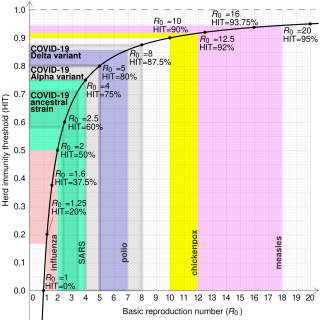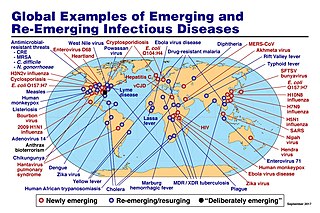
A zoonosis or zoonotic disease is an infectious disease of humans caused by a pathogen that can jump from a non-human to a human and vice versa.

An infection is the invasion of tissues by pathogens, their multiplication, and the reaction of host tissues to the infectious agent and the toxins they produce. An infectious disease, also known as a transmissible disease or communicable disease, is an illness resulting from an infection.

Marburg virus disease is a viral hemorrhagic fever in human and non-human primates caused by either of the two Marburgviruses: Marburg virus (MARV) and Ravn virus (RAVV). Its clinical symptoms are very similar to those of Ebola virus disease (EVD).

An epidemic is the rapid spread of disease to a large number of hosts in a given population within a short period of time. For example, in meningococcal infections, an attack rate in excess of 15 cases per 100,000 people for two consecutive weeks is considered an epidemic.

Infectious mononucleosis, also known as glandular fever, is an infection usually caused by the Epstein–Barr virus (EBV). Most people are infected by the virus as children, when the disease produces few or no symptoms. In young adults, the disease often results in fever, sore throat, enlarged lymph nodes in the neck, and fatigue. Most people recover in two to four weeks; however, feeling tired may last for months. The liver or spleen may also become swollen, and in less than one percent of cases splenic rupture may occur.
A medical condition is a broad term that includes all diseases and disorders.

In epidemiology, the basic reproduction number, or basic reproductive number, denoted , of an infection is the expected number of cases directly generated by one case in a population where all individuals are susceptible to infection. The definition assumes that no other individuals are infected or immunized. Some definitions, such as that of the Australian Department of Health, add the absence of "any deliberate intervention in disease transmission". The basic reproduction number is not necessarily the same as the effective reproduction number , which is the number of cases generated in the current state of a population, which does not have to be the uninfected state. is a dimensionless number and not a time rate, which would have units of time−1, or units of time like doubling time.
Mathematical models can project how infectious diseases progress to show the likely outcome of an epidemic and help inform public health and plant health interventions. Models use basic assumptions or collected statistics along with mathematics to find parameters for various infectious diseases and use those parameters to calculate the effects of different interventions, like mass vaccination programs. The modelling can help decide which intervention(s) to avoid and which to trial, or can predict future growth patterns, etc.
The National Institute of Allergy and Infectious Diseases is one of the 27 institutes and centers that make up the National Institutes of Health (NIH), an agency of the United States Department of Health and Human Services (HHS). NIAID's mission is to conduct basic and applied research to better understand, treat, and prevent infectious, immunologic, and allergic diseases.

Michael Thomas Osterholm is an American epidemiologist, Regents Professor at the University of Minnesota School of Public Health, and director of the Center for Infectious Disease Research and Policy at the University of Minnesota.

An emerging infectious disease (EID) is an infectious disease whose incidence has increased recently, and could increase in the near future. The minority that are capable of developing efficient transmission between humans can become major public and global concerns as potential causes of epidemics or pandemics. Their many impacts can be economic and societal, as well as clinical. EIDs have been increasing steadily since at least 1940.

In health care facilities, isolation represents one of several measures that can be taken to implement in infection control: the prevention of communicable diseases from being transmitted from a patient to other patients, health care workers, and visitors, or from outsiders to a particular patient. Various forms of isolation exist, in some of which contact procedures are modified, and others in which the patient is kept away from all other people. In a system devised, and periodically revised, by the U.S. Centers for Disease Control and Prevention (CDC), various levels of patient isolation comprise application of one or more formally described "precaution".

Coppetts Wood Hospital was an infectious diseases isolation hospital in Muswell Hill, North London. It was used to treat, amongst other things, patients suffering from Tuberculosis and Lassa fever.

Korea Disease Control and Prevention Agency, formerly Korea Centers for Disease Control and Prevention, is an organization under the South Korean Ministry of Welfare and Health that is responsible for the advancement of public health by managing prevention, survey, quarantine, trial, and research on infectious diseases, chronic and rare illnesses and injuries. It was founded in December 2003 and is located in Osong Health Technology Administration Complex in Cheongju. The organization is led by the vice-ministerial-level Commissioner of KDCA.

The Public Health Act 1984 is a piece of legislation for England and Wales which requires physicians to notify the 'proper officer' of the local authority of any person deemed to be suffering from a notifiable disease. It also provides powers to isolate infected individuals to prevent the spread of such a disease. The act forms the basis of various legislation connected to the COVID-19 pandemic in the United Kingdom.
The COVID-19 pandemic was confirmed to have reached the British Overseas Territory of Akrotiri and Dhekelia in March 2020.
Allison Joan McGeer is a Canadian infectious disease specialist in the Sinai Health System, and a professor in the Department of Laboratory Medicine and Pathobiology at the University of Toronto. She also appointed at the Dalla Lana School of Public Health and a Senior Clinician Scientist at the Lunenfeld-Tanenbaum Research Institute, and is a partner of the National Collaborating Centre for Infectious Diseases. McGeer has led investigations into the severe acute respiratory syndrome outbreak in Toronto and worked alongside Donald Low. During the COVID-19 pandemic, McGeer has studied how SARS-CoV-2 survives in the air and has served on several provincial committees advising aspects of the Government of Ontario's pandemic response.
Ghana Infectious Disease Centre (GIDC) is a centre built to improve the medical diagnostic and research capacity of Ghana with regard to infectious diseases. The facility was built due to the emergence of the COVID-19 pandemic in Ghana. Establishing the centre was facilitated by the Ghana COVID-19 Private Sector Fund in collaboration with the Ghana Armed Forces at the Ga East Municipal Hospital in Accra. The old Shai Osudoku District Hospital was also renovated into one of the infectious diseases centres in the Shai Osudoku District in Dodowa. This shares a boundary with the Shai Osudoku District Health Directorate. The president, Nana Addo Dankwa Akuffo Addo, inspected the centre on 30 October 2020

During the COVID-19 pandemic in the Netherlands, various measures were taken by the government. On the advice of the Outbreak Management Team (OMT) set up by the National Institute for Public Health and the Environment (RIVM), many successive decisions were taken in a short period of time. The first preventive measures came into effect on Monday, January 27, 2020.












